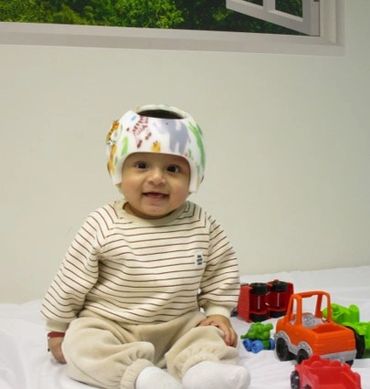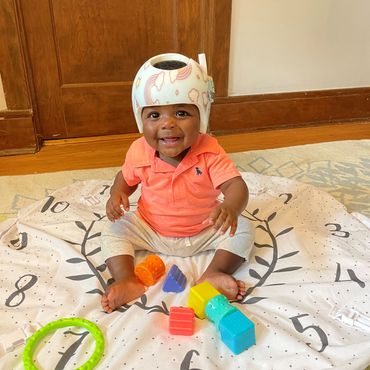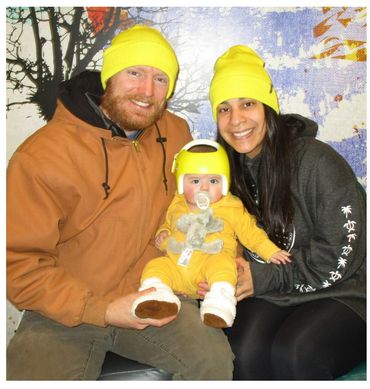Head Shape Clinic
Welcome to Chicago Pediatric Orthotics Head Shape Program
Timing is EVERYTHING when it comes to correcting an abnormal head shape. The best age for treatment is 4-6 months. If you want your baby to be evaluated at the optimum age, we will see you promptly. Call (224) 470-8550 to schedule an evaluation.


The Benefits of beginning treatment at 4 to 5 months
Plagiocephaly, commonly known as flat head syndrome, affects many infants and can cause concern for parents. While the condition is typically not harmful to a baby's brain development, it can have cosmetic and structural implications if left untreated. Starting treatment early—particularly around the four to five-month mark—offers a range of benefits that can positively impact both the child and the family.
Early Diagnosis Enables Timely Intervention
By four months of age, most babies have reached important developmental milestones, such as holding their heads up and beginning to roll over. These skills can make certain treatment methods, such as repositioning therapy and physical exercises, more effective. At this age, the baby’s skull is still malleable, making it more responsive to corrective measures.
Effectiveness of STARband Cranial Orthotic
If helmet therapy or cranial orthotic devices are recommended, starting at four months maximizes their effectiveness. The rapid growth of an infant's head during the first year of life allows for significant correction within a relatively short time. Initiating treatment at this stage means the helmet or band can guide the skull’s natural growth, helping to shape it symmetrically before the bones begin to harden.
Reduced Treatment Duration
Treating plagiocephaly earlier often results in a markedly shorter treatment duration. By addressing the issue during this critical period of growth, the need for prolonged use of corrective devices is minimized. This not only reduces the burden on parents but also makes the experience less intrusive for the baby.
Improved Long-Term Outcomes
Untreated plagiocephaly can lead to asymmetries in facial features, jaw alignment issues, and, in rare cases, difficulties with fitting helmets or glasses later in life. Starting treatment at four months significantly reduces the likelihood of these complications, ensuring better aesthetic and functional outcomes as the child grows.
Addressing plagiocephaly early can also contribute to a baby’s overall development. For instance, physical therapy exercises designed to alleviate flat spots often enhance motor skills and strengthen neck and shoulder muscles. This comprehensive approach not only corrects the condition but also promotes healthy growth and development.
Practical Tips for Parents
If you’re considering treatment for your baby’s plagiocephaly, here are a few tips to get started:
- Schedule a head shape evaluation with one of our head shape experts: Call (224) 470-8550 and you will be scheduled within 2-3 days of your call. Discuss your concerns to determine the severity of the condition and explore treatment options. Have baby’s head scanned with our non-invasive, STARscanner to objectively evaluate the shape to help you decide the best treatments.
- Incorporate Tummy Time: Ensure your baby spends plenty of supervised time on their tummy to relieve pressure on the back of their head and activate the muscles that pull on the flat areas to help with reshaping. We recommend a minimum of 60 minutes daily.
- Stay Consistent: Follow through with recommended therapies. Cranial remolding treatment works fastest and corrects head shapes best with 23 hour use of the device.
- Contact your insurance provider: Ask if 'S1040 Custom Cranial Remolding Orthosis' is included in your plan. Be sure to ask what your remaining deductible is for the year and if there is a copayment.
THERE ARE A FEW SECRETS TO CORRECTING A BABY'S HEAD SHAPE ABNORMALITY
- Have your child evaluated by our head shape clinic at a very young (6 weeks to 4 months) to evaluate strength, range of motion and head shape.
- Begin formal physical therapy if your child has a head turn preference or does not tolerate tummy time.
- Start STARband treatment at 4-5 months of age -This is the age when the skull bones are still soft/malleable and the rate of head growth is fastest.
- Increase waking tummy time to 60 minutes or more daily.
Meet a few of our STARband cuties!! Submit your photos to chicagopediatricorthotics@gmail.com
.jpg/:/rs=w:370,cg:true,m)

.jpg/:/rs=w:370,cg:true,m)






Head shape clinic. Cranial Experts. Cranial Band. STARband
Baby Helmet Specialists
Pat Rogel, CO, LO, OTR/L, and Ryan Schutzle, CPO, are recognized as national experts in cranial remolding treatment. Together, they have successfully provided thousands of custom plagiocephaly helmets to infants using the most advanced cranial technology available, correcting countless cases of head shape abnormalities. Their extensive experience spans all styles of cranial bands used to treat plagiocephaly, and after working with numerous brands, they have found the STARband to be the most effective. As leaders in the field, both are sought-after speakers at professional conferences, sharing expertise in cranial remolding care and advancements in treatment.
At Chicago Pediatric Orthotics, many of the babies we evaluate do not require helmet treatment. Our team conducts thorough evaluations and provides honest recommendations, including whether outside physical therapy or a cranial band is needed. We are equally comfortable sending families home without a helmet when treatment isn’t necessary, but if a helmet is required, our goal is to correct the head shape with just one.
Unlike clinics owned by investment groups, Chicago Pediatric Orthotics is caregiver-owned. Our staff is focused solely on delivering excellent care, not meeting quotas, ensuring every decision is made with your baby’s best interest at heart.
STARscanner Excellence
Chicago Pediatric Orthotics is one of TWO STARscanner facilities in the Chicago area. The STARscanner is the fastest cranial technology available to evaluate head shape.
Baby Helmet; Head shape evaluation; Plagiocephaly Helmets; Cranial band; Cranial Remolding ; Torticollis; Brachycephaly; Flat head; Infant helmet
One Cranial Band Guarantee
99% of our treatment will correct plagiocephaly/flat head syndrome with one cranial band. One STARband.
Conveniently located in Skokie to serve Chicago and the suburbs.
Call to schedule a head shape evaluation.(224) 470-8550

CLICK LINK TO SEE COLOR OPTIONS
Visit https://www.orthomerica.com/product-category/transfer-patterns/ to see what colors are available.
This is an example expected results with ONE STARband. Before (left), after (center) birds-eye view of two babies. Cross section right shows progress.

Plagiocephaly and Torticollis
Do you have questions about treatment for plagiocephaly and torticollis? To learn more about a plagiocephaly helmet, please visit https://www.starbandkids.com/does-my-child-have-a-problem/
or https://www.youtube.com/watch?v=dK9XbYsy45U
CALL TO SCHEDULE AN EVALUATION
(224) 470-8550
Note: We see infants as young as 3 weeks old for evaluations. Our hope is to prevent the need for a cranial helmet. The younger a baby is, the more options there are for treatment.
Chicago Pediatric Orthotics has a signed a HIPAA compliant photo release signed by the parents of pictured children. The release allows us to display the photos on our website and social media pages.
This website uses cookies.
We use cookies to analyze website traffic and optimize your website experience. By accepting our use of cookies, your data will be aggregated with all other user data.